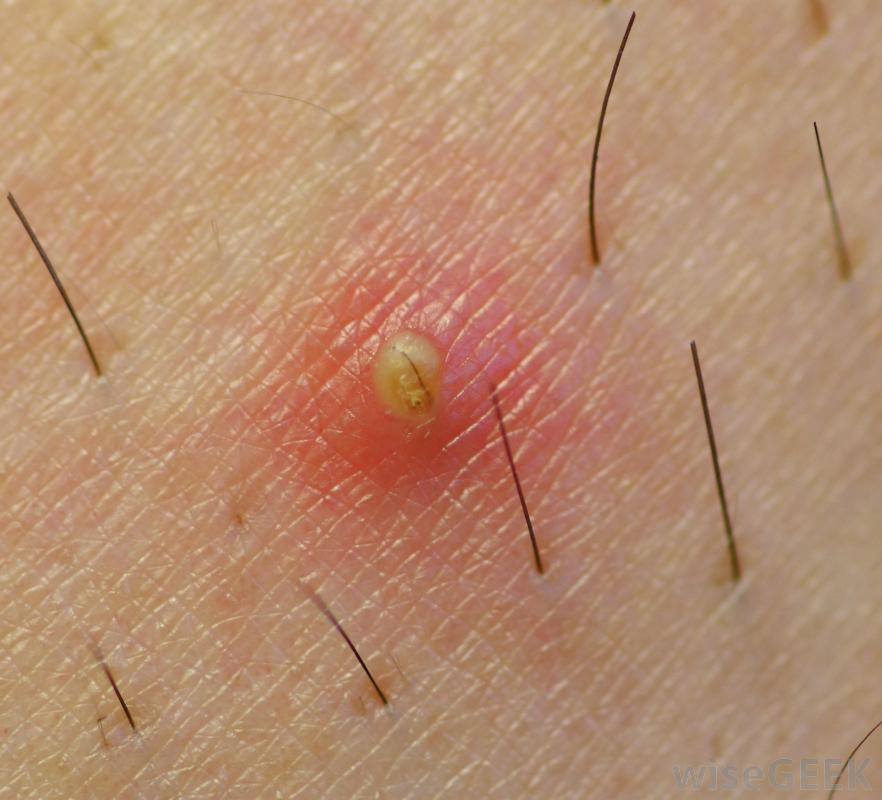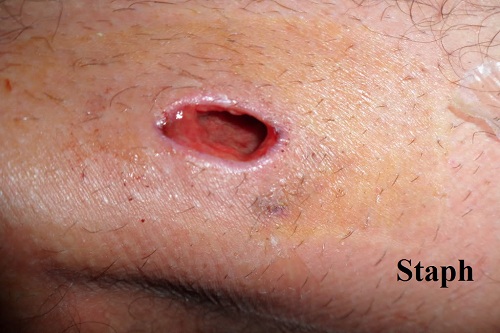Ingrown hair is hair that has curled and grown back into the skin instead of growing outwards. This may cause itching, swelling or a burning sensation. An infected ingrown hair is filled with pus. Anyone can get this condition, but people with coarse and curly hair are at a higher risk. It mostly happens after a hair removal procedure. Dirt, dead skin and excess oil can block hair follicles leading to this condition.

Symptoms of Infected Ingrown Hair
1. Redness of Skin
An ingrown hair will become inflamed and red after some time. This will cause discomfort in the surrounding skin tissues.
2. Cluster of Small Bumps
If the infection is serious, a cluster of small bumps will appear and might appear whitish, yellowish or reddish in color.
3. Large Swollen Bump
A big bump might appear in the case of a deep ingrown hair. It mostly shows up in areas that are shaved frequently.
4. Itching and Burning sensation
If you have an infected ingrown hair, you will experience folliculitis itch. A burning sensation occurs that makes you feel itchy. However, it is not advisable to pick the area as you might end up spreading the infection.
5. Pain and Tenderness
Pain and tenderness will normally occur in case of an infection. The pain is even worse if the infection becomes a cyst.
6. Fluid Filled Blisters
Blisters will form and be filled with yellow and smelly pus. Oozing might occur and a crust is formed.
When to See a Doctor
Infected ingrown hair can range from cysts, which might need surgical removal or antibiotics, to Staph, a disease that is bacterium-based and forms serious looking craters. Staph bacteria leads to an open wound increasing the risk of getting complications and more infections. If you experience extreme pain or inflammation, it is important to seek medical attention.

How to Treat or Remove Infected Ingrown Hair
1. Apply Warm Compress and Remove
A warm compress will soften the skin. Use a wet wash cloth with hot water, wring it and compress against the ingrown hair. When it becomes cool, dip it in hot water again. If the ingrown hair is visible, this method will enable it to come close to the surface. If it is not visible, use the compress until the ingrown hair rises to the surface. If you use the compress for more than 10 minutes but you cannot see the hair, it might not be possible for you to remove it yourself or it might be something different.
2. Tease the Hair Out of Skin
You can use tweezers, a sterile needle or medical equipment to tease the hair. Avoid plucking completely and just ensure the ingrown end of the hair is above the skin surface. You will need to be patient to remove the hair without cutting your skin. You might see a loop of hair growing downwards. Use a needle to lift the loop gently. If you are using tweezers, it is better to use pointy tweezers to avoid damaging the skin.
3. Dab Acne Medication
Infected ingrown hair is similar to a pimple, more so when it has pus. Dab salicylic acid or benzoyl peroxide for a few days several times a day. This, together with exfoliation, will help the ingrown hair to come out by reducing the swelling. If you do not have acne medication, you can dab toothpaste or use the aspirin method.
4. Exfoliate Gently
Scrub the ingrown hair twice a day gently. The ingrown hair might be trapped by oil, dirt and dead skin cell which can be removed exfoliation. Use different means of exfoliation. You can try using an ingrown hair brush, exfoliating glove, salt or sugar and olive oil.
5. Other Home Remedies
- Aspirin
Aspirin will reduce inflammation and redness. The salicylic acid will scrub off dead skin. Make a paste using 2 aspirin tablets and 1 tablespoon of water. Add honey to the paste and apply it on the infected area. After 10 minutes, wash it off with warm water and pat dry.
- Baking Soda
Baking soda is soothing because of its anti-inflammatory properties. It exfoliates the skin and relieves itching. Make a solution using a tablespoon of baking soda and a cup of water. Dab on the affected area and then wash off with cold water after 5 minutes. You can also make a scrub by mixing 1 tablespoon of baking soda, 1 tablespoon of oatmeal and 1 tablespoon of water. Apply and rinse off using warm water after 5 minutes or less.
- Tea Tree Oil
Tea tree oil has anti-inflammatory, antiseptic and antibacterial properties. This helps heal the skin. Wash the affected area using antibacterial soap and apply a tea tree oil solution (5 drops of tea tree oil mixed with 2 tablespoons of distilled water). Let it rest for 10 minutes and then rinse using warm water. You can also mix 3 drops of tea tree oil with 1 tablespoon of olive oil and apply on the affected area. Rinse with warm water after 10 minutes.
- Apple Cider Vinegar
Apple cider vinegar has anti-inflammatory properties that decrease inflammation and soothe the skin. It also fights yeast and bacteria, decreasing the risk of infection. Apply the apple cider vinegar using cotton wool. Let it sit for a while and then rinse with warm water.
How to Prevent Infected Ingrown Hair
- Sterilize hair removal tools before use. Clean the tweezers and needles with alcohol to kill germs that may lead to infections. You can also boil them before use.
- Do not pick an ingrown hair with dirty hands. Use cotton wool and salicylic acid to clean the area instead.
- Use a moistening gel to reduce friction between the blade and skin when shaving. After 3 shaves, discard the blade and use a new one. The shaving tools and blades should be kept in a dry place away from the shower.
- Do not shave too closely to the skin. Bacteria can find its way into the tiny holes after shaving.
